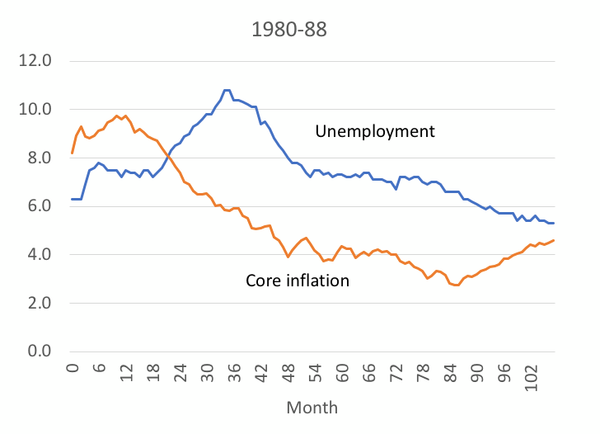5/11付けエントリでクルーグマンが以下の2枚のグラフを示している。


クルーグマンによれば、これらの図は自然失業率仮説がもはや成立しなくなったことを意味するという。曰く:
Underlying the natural rate hypothesis is “accelerationism”: the idea that low unemployment will lead not just to high inflation, but to accelerating inflation, and conversely that high unemployment will not just reduce inflation but lead to ever-falling inflation.
Accelerationism used to look like a pretty good description of inflation experience. Consider the big slump of the early 1980s. Unemployment soared for a while, then came back down to about where it started. Inflation, however, didn’t go back to where it started: it came down by about 5 percentage points:
But that was a long time ago. Consider what happened after the financial crisis of 2008. As in the 1980s, unemployment soared for a while, then eventually came back down. But inflation barely moved at all; in particular, it ended the cycle just about where it started:
(拙訳)
自然失業率仮説の背後にあるのは「加速説」である。それは、低失業率は高インフレを招くのみならず、加速的なインフレを招き、逆に高失業率はインフレを低下させるのみならず低下し続けるインフレを招く、という考えである。
加速説は、かつてはインフレの実際の推移をかなり良く描写しているように思われた。1980年代初めの大きな景気後退を見てみよう。失業率はしばらくの間高止まりし、その後、ほぼ元の水準に戻った。しかし、インフレは元の水準には戻らず、それより約5%低下した。
だがそれは大昔の話である。2008年の金融危機後に起きたことを見てみよう。1980年代と同様、失業率はしばらく高止まりしたが、最終的には元に戻った。しかしインフレはほとんど動かなかった。即ち、この循環の最後においても最初と同じ位置にあった。
このエントリは5/6エントリのフォローアップであるが、そちらのエントリでクルーグマンは、自分の考えはブランシャール(cf. ここ)と同じだ、と述べている。その上で、この事象が意味する政策的含意を以下の2枚のグラフで示している。


1枚目は加速説に基づく失業率の推移のグラフである。この場合、高失業率は期待インフレを低下させるので、インフレ率を元の水準に戻すために、政策当局者は経済をしばらく過熱させ、失業率を長期的に維持可能な水準を下回って推移させなければならない。その結果、経済が過熱した時期は当初の景気後退のコストを相殺し、全循環期間(この例では10年)の平均失業率は景気後退が無かった場合と概ね同じになる。
しかし、加速説がもはや成立しないという2枚目の図の見解――クルーグマンはこれを新古代ケインジアン(neo-paleo-Keynesian)的見解と呼んでいる――では、インフレを元に戻す際に経済を過熱させる必要はなく、単に失業率を元の水準に戻せばよい。従ってこの場合には当初の景気後退のコストは相殺されないままとなる。
クルーグマンはエントリを以下のように結んでいる。
On that view, the failure to supply enough demand after 2008 imposed an enormous cost, which we can never regain. And looking forward, the risks of being too loose versus too tight are hugely asymmetric: letting the economy slump again will again impose big costs that are never made up, while running it hot won’t store up any meaningful trouble for the future.
Is this reality being reflected in policy? My sense is that a lot of economists in central banks have come around to a neo-paleo view of inflation. But actual policy still looks as if it’s being run with an accelerationist Phillips curve in the background, at best; indeed, there’s an obvious unwillingness even to temporarily let the economy run hot.
This matters. We should not let policy be driven by ideas that haven’t worked for decades.
(拙訳)
この見解では、2008年以降に十分な需要を供給できなかったことは莫大なコストをもたらし、それを埋め合わせることは決してできない。先行きについて言えば、緩和し過ぎのリスクと引き締め過ぎのリスクは大いに非対称的である。景気を再び後退させることは、決して埋め合わされることのない大きなコストをまたもやもたらすことになる。一方、景気を過熱させることは、将来にさして問題を残さない。
この現実は政策に反映されているだろうか? 私の感覚では、中銀の経済学者の多くはインフレの新古代見解に同調するようになった。しかし、実際の政策は、良く言って未だ加速説のフィリップス曲線に基づいて運営されているように見える。実際のところは、経済を一時的に過熱させることについてさえ明確な抵抗がある。
これは問題である。我々は、過去数十年上手く機能しなかった考えに基づいて政策を運営させるべきではないのだ。